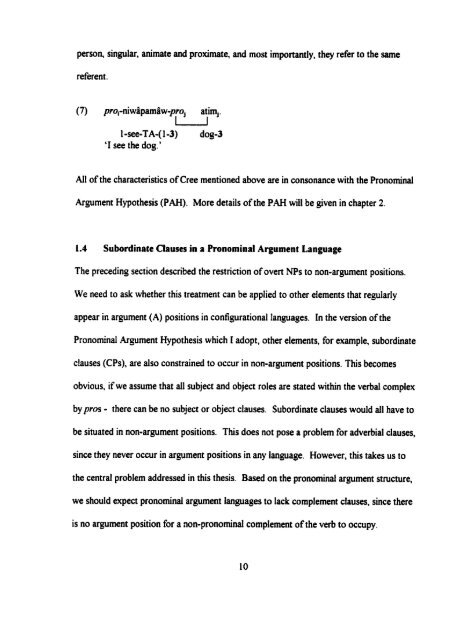Adverbial and Argument-Doubling Clauses in Cree - MSpace
Adverbial and Argument-Doubling Clauses in Cree - MSpace
Adverbial and Argument-Doubling Clauses in Cree - MSpace
You also want an ePaper? Increase the reach of your titles
YUMPU automatically turns print PDFs into web optimized ePapers that Google loves.
person, s<strong>in</strong>gular, animate <strong>and</strong> proximaie, <strong>and</strong> rnost importantly, they refer to the same<br />
referent .<br />
1 -sec-TA-( 1 -3) dog-3<br />
'1 see the dog.'<br />
Al1 of the characteristics of <strong>Cree</strong> rnentioned above are <strong>in</strong> consonance with the Pronom<strong>in</strong>al<br />
<strong>Argument</strong> Hypothesis (PAH). More details of the PAH wiil be given <strong>in</strong> chapter 2.<br />
1.4 Subord<strong>in</strong>ate Ctausa <strong>in</strong> a Pronom<strong>in</strong>al <strong>Argument</strong> Language<br />
The preced<strong>in</strong>g section descnbed the restriction of overt NPs to non-argument positions.<br />
We need to ask whether this treatment can be applied to other elements that regularly<br />
appear <strong>in</strong> argument (A) positions <strong>in</strong> configurational langages. In the version of the<br />
Pronom<strong>in</strong>al <strong>Argument</strong> Hypothesis which I adopt, other elements, for example, subord<strong>in</strong>ate<br />
clauses (CPs), are also constra<strong>in</strong>ed to occur <strong>in</strong> non-argument positions. This becomes<br />
obvious, if we assume that al1 subject <strong>and</strong> object roles are stated with<strong>in</strong> the verbal complex<br />
bypros - there can be no subject or object clauses. Subord<strong>in</strong>ate clauses would dl have to<br />
be situated <strong>in</strong> non-argument positions. This does not pose a problem for adverbial clauses,<br />
s<strong>in</strong>ce they never occur <strong>in</strong> argment positions <strong>in</strong> any laquage. However, this takes us to<br />
the central problem addressed <strong>in</strong> this thesis. Based on the pronom<strong>in</strong>al argument structure,<br />
we should expect pronom<strong>in</strong>al argument languages to lack complement clauses, s<strong>in</strong>ce there<br />
is no argument position for a non-pronom<strong>in</strong>al complement of the verb to occupy.








![an unusual bacterial isolate from in partial fulf]lment for the ... - MSpace](https://img.yumpu.com/21942008/1/190x245/an-unusual-bacterial-isolate-from-in-partial-fulflment-for-the-mspace.jpg?quality=85)




![in partial fulfil]ment of the - MSpace - University of Manitoba](https://img.yumpu.com/21941988/1/190x245/in-partial-fulfilment-of-the-mspace-university-of-manitoba.jpg?quality=85)


